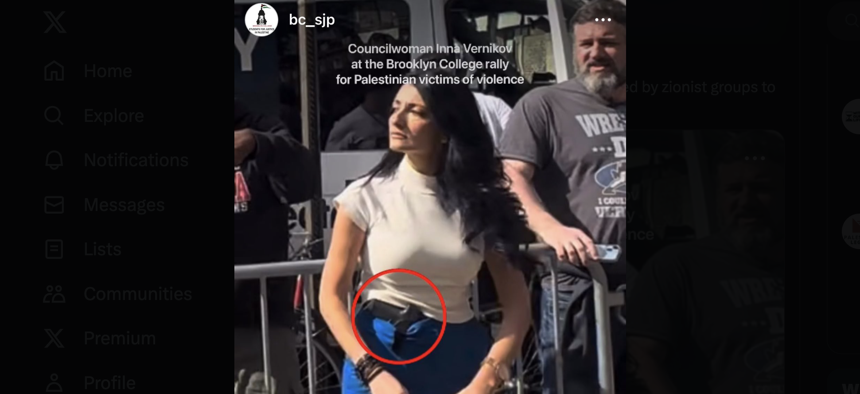Politics
Council Member Inna Vernikov brought a gun to a protest. Did she break the law?
Openly carrying a pistol to a college protest could fall afoul of New York state’s strict gun laws.

A screenshot of an Instagram post by Brooklyn College Students for Justice in Palestine shows City Council Member Inna Vernikov openly carrying a handgun. Brooklyn College Students for Justice in Palestine
Editor's note: Hours after this story was published, the New York City Police Department confirmed to City & State that Inna Vernikov was arrested on a gun possession charge after turning herself in early Friday morning.
On Thursday, New York City Council Member Inna Vernikov showed up to a pro-Palestine protest outside Brooklyn College packing heat, which a civil rights attorney told City & State may have violated multiple state gun laws.
Vernikov was opposed the protest, which she labeled antisemitic, and worked with the City University of New York to move it from the Brooklyn College campus onto a public street in between college buildings. In a joint press release with Council Members Farah Louis and Kalman Yeger, Vernikov announced that she and the other council members would be on hand at the protest to help any students who felt unsafe. Photos and videos of her at the rally show a pistol stuck into the front of her pants, with the grip clearly visible.
Vernikov, who was recently featured in a New York Post spread on new gun owners, has a state concealed carry permit for her handgun. But New York state still places many restrictions on permit holders. M.K. Kaishian, a former public defender who now runs her own civil rights practice, said that openly carrying a pistol to a protest outside of a college could have violated multiple state gun laws.
Kaishian has represented dozens of clients in gun possession cases. Many of them were Black and Latino men with few resources. While Kaishian believes that it’s unlikely Vernikov will be charged with anything, given council member’s political and institutional power, she said that if one of her clients had done what Vernikov allegedly did, there are a number of felonies they would likely be charged with.
One of those is a law passed during a special legislative session last year that prohibits the possession of firearms at certain “sensitive locations,” which include protests and rallies. “Under the current law, it's illegal, even with a concealed carry license, to carry a handgun at a place where people are gathering to rally in accordance with their First Amendment rights,” Kaishian said. Schools, including colleges and universities, are also included in the list of “sensitive locations.” So carrying a gun at a rally outside of a school could result in two separate counts of violating the same sensitive location law. There’s also a separate, largely redundant law that specifically outlaws carrying a firearm on school grounds.
It’s not entirely clear whether the Brooklyn College protest technically occurred on school grounds or not – it was held on a public street in between college buildings – but prosecutors have been known to indict first and ask questions later. “What prosecutors usually do when someone is caught with a gun in public, even if it's not visible, and even if it only became visible after somebody was illegally searched, is charge that person with everything that could possibly stick,” Kaishian said.
Openly carrying guns in public is also illegal. New York state only issues concealed carry permits for handguns, which do not allow their holders to carry their guns openly. Someone who carried a pistol in her waistband with the grip clearly visible could be charged with “menacing in the second degree.” The law defines “menacing” very broadly, as displaying a deadly weapon and placing someone in reasonable fear. “I think if you're showing up with a visible gun to intimidate a group of college students who are gathering legally, there's a strong argument that would constitute menacing,” Kaishian said, adding that poor nonwhite defendants are routinely charged under the menacing law for doing less than what Vernikov allegedly did.
Vernikov might protest that she was only carrying the gun for self-defense, not to menace anyone at the rally. But such a defense is unlikely to work. At least, it generally doesn’t work for the kinds of people that Kaishian represents. “Almost everyone that I represent has a legitimate self-defense argument about why they would want to carry, and that argument is no different than that of any other American who owns guns,” Kaishian said. “Except in many cases for people in New York City who do not have the entitlement and privileges that the council member has, those concerns are not taken seriously at best and are laughed off and denigrated at worst.”
Menacing in the second degree is a Class A misdemeanor, which carries a theoretical maximum sentence of one year in jail, while the other counts are Class E felonies, which carry a maximum sentence of four years in prison. None of these are considered violent or bail-eligible crimes, which means that someone charged under these statutes would not be sent to Rikers for pretrial detention.
Assuming they accepted a plea deal, they would be unlikely to face any prison time at all. “I would anticipate for a client who was charged with a top count E felony like possession of a weapon in a sensitive area that you'd get an A misdemeanor and avoid any sort of potential jail exposure,” Kaishian said.

NEXT STORY: Exclusive: Working Families Party endorses Claire Cousin for a Hudson Valley Assembly seat
